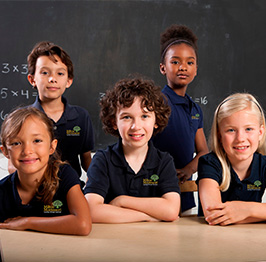Elementary Curriculum

At Milton Montessori School, we believe that children learn best through their interactions with and within the purposefully prepared Montessori environment. By exploring, experimenting, touching, building and doing students progress through the subject areas. The Montessori curriculum in the Lower Elementary consists of areas of study that are interconnected with each other. This is what Maria Montessori called the “Cosmic Education”. She believed that there were two things necessary for raising peaceful human beings: an awareness of interdependence and the sense of gratitude that comes from that awareness. By providing a holistic, therefore Cosmic education, children receiving these lessons learn to be grateful to previous generations so that they may benefit from their knowledge. Children study areas such as History, Botany, Geography, Zoology, Biology, Geometry, Math and Languages and all their interconnectedness.
LOWER ELEMENTARY
Continuing your child’s education in the lower elementary program reinforces positive learning habits. For new students just joining at this level, many enjoy the freedom and responsibility given in the classroom. Students learn that the teacher is not the sole source of information, and that they can depend on one another as a community of learners. Students who have mastered concepts are able to teach those who may still be practicing.
LANGUAGE:
Montessori classrooms are very language rich. There is reading, writing, speaking and listening experiences woven into every area of the classroom and curriculum. The language area in the lower elementary classroom emphasizes the important concepts and skills students need as they develop fluency in all areas associated with literacy. When Maria and Mario Montessori were creating the language curriculum, they focused on grammar, mechanics, punctuation, capitalization, word study, and sentence analysis. In grammar, children are exposed to noun, verb, adjective, article, preposition, adverb, conjunction, pronoun, and interjection before third grade. They are taught to recognize and symbolize these parts of speech. They also learn that sometimes words can be different parts of speech depending on how the word is used in the sentence. Children develop a deep understanding of grammar in the Montessori elementary program. They will also learn about all the mechanic marks, such as: period, question mark, exclamation mark, quotations, comma, apostrophes, and hyphens and how and when to use them in their writing. There is also a section of the Montessori language curriculum called word study. This area teaches children about compound words, antonyms, synonyms, contractions, homophones, and homographs. This curriculum strand teaches the child a concept while broadening their vocabulary. Sentence analysis helps children break down the parts of a sentence, in turn, making them better writers.
MATH:
Math manipulatives (hands-on materials) are some of the most elegant and intuitive of the Montessori materials. Daily practice with these materials enables your child to begin to move from concrete to abstract reasoning. Research shows the optimum development of mathematical understanding involves linking the two hemispheres of the brain (the right being concrete/experiential, the left symbolic/linguistic). This natural way of learning concepts is fundamental to the Montessori approach to learning mathematics.
Students learn the four operations (addition, multiplication, subtraction and division), fractions, decimals, estimation, measurement, graphing, word-problems, patterns and relationships. Using two and three-dimensional materials, students learn geometric concepts such as lines, angles and polygons, understanding their parts and discovering relationships. When students are ready, teachers introduce them to advanced math and geometric concepts and activities, with each student progressing at their own pace.
SCIENCE AND CULTURAL STUDIES:
The cultural studies in the Montessori classroom are emphasized with the study of the four main topics under the heading of culture: botany, zoology, history, and geography. Botany is the study of plants and the children learn about their parts and types. They gain an appreciation for plants and begin acting as stewards of the earth by taking care of plants. In history, children begin to understand time. They make their own timelines and begin to understand the time and events that happened in the past and what may be ahead in the future. They learn about people that came before them and what they contributed. They also study the period when dinosaurs walked the earth, ancient and historical time periods, and astronomy. In geography, the children begin by learning about the landforms, the globe, cardinal directions, rocks and minerals, volcanoes, and the earth’s topography. In zoology, the children learn all about animals. They get to compare parts, systems and ecosystems; identifying similarities and unique characteristics. These lessons take place both inside and outside the classroom, as our outdoor environments are utilized.
PRACTICAL LIFE:
Practical life, in the elementary classroom, builds on the skills they’ve learned during their experience in the primary classroom. Students continue their care of their environment, cleaning, dusting, cooking, gardening and maintaining our outdoor areas. As children become more and more self-reliant, they become responsible for choosing and completing their work independently. They develop self-reliance and time management skills. The children enjoy learning because it is at their own pace. Community is emphasized in the lower elementary classroom as the students work together to solve their own problems.
UPPER ELEMENTARY
In the upper elementary classroom (fourth through sixth grade, or ages nine to 12), content is not presented in “course subject” form; instead, ideas and concepts are explored across the breadth and to the depth demanded by the child. For example, flowers are not just observed in books or through the window. The flower (possibly cultivated by the child) is brought into the environment, touched, named, identified by parts, compared and contrasted with other plants, reviewed within its life cycle, located in the world, etc. Thus, education is more about experiencing and relationships than dissemination of isolated facts from a pre-selected course of study. The senses are engaged whenever possible, aiding in the child’s natural capacity to learn.
Social development takes on a more prominent development at this age. Individual morals and values are further established, particularly within the framework of peers. The sense of self is expanded beyond personal experience. Abstract experiencing through literature, arts, etc. further develops and can modify the child’s sense of self. Decision-making skills and problem-solving skills are self-tested, and success is qualified as learning from both the positive and negative experiences of life.
The child of this age wants to know how everything came to be, the history of the universe, the world, humans. He wants to be important, to learn to direct his own life and learning. Given freedom and trust, he will explore, learn, and create in directions we could not have predicted, and accomplish amounts of work we would never have demanded. The child at this age explores areas usually not introduced until high school, such as algebra, square and cube root, geometry, botany and zoology, evolution and classification, chemistry and physics experiments, the history of math and language, grammar and sentence analysis, and composition. They learn to love these studies, and nothing could better prepare them for later work in these areas. Montessori upper elementary children work together to do research, plan and execute projects, and to share them with other members of the class who are interested. They learn to work in multiage and multi-ability groups, making use of the interests and abilities of all. This is excellent preparation for adult life in a peaceful society. The Montessori-trained adult teaches the child how to teach, facilitates social development, and creativity, supports independent thinking, and provides an environment for uninterrupted concentration by the individual child.
Except for a state required curriculum, which takes very little time when children are working individually at their own pace, lessons in the Montessori elementary class are not only offered but required of the children. Children learn to plan and to be responsible for their own work. There are certain ages when we have found that children are often interested in each subject, but the wise adult follows the child, knowing that the human mind works on its own, guided by a power within.
LANGUAGE:
Upper Elementary language arts include listening and speaking, comprehension, vocabulary, spelling, grammar, and writing skills. Students participate in journal writing, process writing, and formal writing including book reports, essays, and writing assessments.
Speaking skills, speaks publicly before a small group, communicating ideas effectively, Informative presentation, Persuasive presentation, distinguishes between feelings, emotional, and rational information, Participates in reports, oral presentations, drama, debates, etc.
Comprehension, Sequences events in a story by beginning, middle, an end, Reads and answers comprehension questions on grade level with > 80% accuracy, determines fact or opinion in statements, determines cause and effect, makes predictions, draws inferences, and conclusions from what is read
WORD STUDY:
Defines and creates compound words, contractions, Defines and identifies root word, suffixes, and prefixes, defines and applies examples: Antonyms, anonyms, synonyms, homonyms, similes, metaphors, Uses reference texts appropriately
SPELLING SKILL:
Uses spelling strategies to accurately spell words, Spells words at grade level using knowledge of spelling rules and patterns
Grammar: Defines parts of speech and identifies each part within a sentence, Adjectives: Personal, antecedents, agreement, nominative, objective, possessive, reflexive intensive, demonstrative, interrogative, indefinite, Conjunctions: coordinating, correlative, subordinating ,interjections, prepositions, and prepositional phrases,: subject; predicate; direct object, Complete, simple, compound, hidden subjects, Verb tenses and conjugation: simple, principle parts, compound, perfect, progressive tenses, Clauses, phrases, and sentences, Punctuation: Correctly utilizes hyphen, colon, semi-colon, and quotation marks
WRITING SKILLS:
Writing process: Prewrite (making notes, generating a web, creating an outline) creating a draft (handwritten process writing on lined paper, skipping lines): revising (intended audience, clarity, word choice, peer conferencing), Editing (correcting grammar, spelling, punctuation; use of common editing marks), Capitalizes correctly, utilizes punctuation correctly: end marks; commas; quotation marks; colons; semicolons; hyphens; abbreviations; apostrophe applies grammar skills to writing, applies spelling skills to writing
MATHMATICS:
Knows place value concepts through billions: Understands positive and negative numbers and number line, Sequences from least to greatest, numbers to one billion, Sequences decimals from least to greatest, Sequences fractions from least to greatest. Understands positive and negative numbers and number line.
Subtracts fractions, Equivalent fractions, Proper and improper, converted to decimals, converted to percentages, subtracts positive and negative numbers Multiplies with two and three digit multipliers,
Moves decimal point appropriately to maintain correct place value, multiplies fractions, calculates least common multiple, Equivalent fractions, converts proper and improper fractions, Converts fractions to decimals and percentages, Multiplies positive and negative numbers, Factors numbers, Understands prime numbers, Understands prime factorization, Understands composite numbers, calculates greatest common factor
Our ultimate goal in the Elementary Program at Milton Montessori School, is to help our students develop into adults who have the intellect, integrity, compassion, strength of character, skill and creativity needed to seek common ground and establish mutuality with others of various cultures and religions in order to pursue a peace that ensures human dignity and respect, social and economic justice, and the health and well being of the planet.


